Home > Nanotechnology Art Gallery > Weiss Group
Weiss Group
Click image to enlarge. All images © respective artist or company.
See Featured Images of the Weiss Group.
"We focus on gaining atomic-scale understanding and control of materials properties. We do this by exploring, probing, and manipulating interactions and dynamics at surfaces and interfaces. We use and extend scanning tunneling microscopy to explore the surface structures, motion, and perturbations due to adsorbed atoms and molecules and due to surface features such as substrate steps and defects. We locate, study, and try to exploit the regimes in which our intuition based on macroscopic measurements breaks down. We are exploring the phenomena to be used, the ground rules, and the ultimate limits in nanometer-scale electronics and storage. Our microscopes serve not only as probes, but also allow us to manipulate matter on the atomic scale. We can thus interrogate the properties of uniquely configured atomic-scale structures. This has required the development of new tools with atomic-scale views of the surface. One new effort in our group looks at how we can bridge the gap between conventional optical microscopies and scanning probe microscopies."
—Paul S. Weiss, Professor of Chemistry, Pennsylvania State University.
Self-Assembled Monolayers - Vapor Phase Annealing
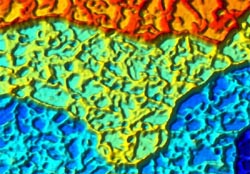
A scanning tunneling microscope image (200nm x 140 nm) of a self-assembled monolayer of n-decanethiolate on Au{111} that has been vapor-annealed in n-dodecanethiolate. The protrusions on each of the atomic steps are the 1.1 Å higher n-dodecanethiolate molecules. Image by: Z. J. Donhauser
|
CS2 on Au{111}
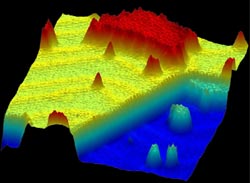
"Surfing a wave" - CS2 riding an electronic surface state on Au{111}
236 Å x 236 Å, image of 0.2 ML CS2 on Au(111) at 4 K (Vtip = + 0.5 V, I = 200 pA). Image by: E. H. Sykes & P. Han
|
Playing billiards with electrons on a golden table
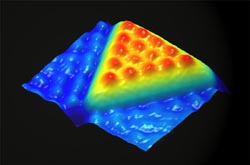
Ripples in the electron density of a stepped gold surface taken using scanning tunneling microscopy at 4 Kelvin. The central triangle is a single atom high terrace containing ~ 650 gold atoms. The "billiard balls" are maxima in the electron density at the Fermi level and are caused by constructive interference of the electron waves as they bounce off the edges of the triangular gold box. Quantum mechanics lets us solve the structure using particle in a box equations. We are now investigating how molecules interact with the electron density in these systems. Image by: E. H. Sykes, P. Han, & B. A. Mantooth
|
Molecular Rulers
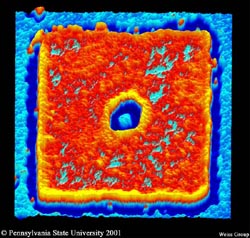
A field emission scanning electron microscopy image showing a ~30 nm gold dot formed in the center of a hollow gold parent structure supported on an oxidized Si substrate. This nanostructure was fabricated by a 'molecular ruler' resist process developed to extend the range of conventional nanolithography techniques. Image by: A. Hatzor & B. A. Mantooth
|
Self-Assembled Monolayers
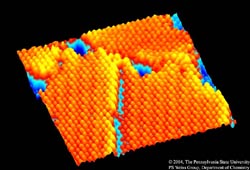
A scanning tunneling microscope image (15 nm x 15 nm) of a self-assembled monolayer of n-decanethiolate on Au{111}. The individual molecules closely pack into a hexagonal array. Features of the assembly and surface, respectively, including domain boundaries (light blue stripe) and gold vacancy islands (circular blue depressions) are easily seen. Image by: R. K. Smith & B. A. Mantooth
|
Pd/H PSU
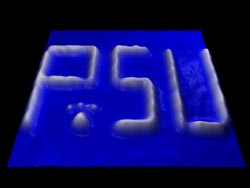
A scanning tunneling microscope image of subsurface hydrogen in palladium at 4 Kelvin. The letters are 0.3 Å high and 40 Å wide, and arise from an outward relaxation of the Pd{111} surface atoms to accommodate hydrogen atoms in the subsurface region. The letters are created by inducing segregation of bulk hydrogen to interstitial sites directly below the surface using voltage pulses applied to the microscope tip. Image by: E. H. Sykes, L. Fernandez, & B. A. Mantooth
|





